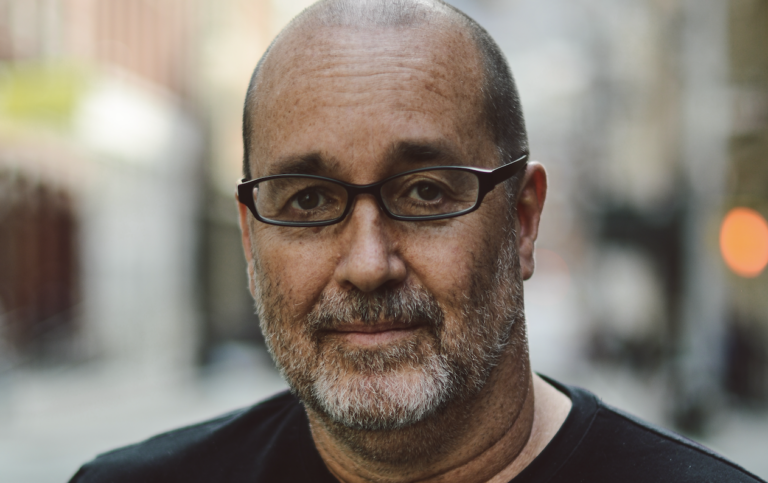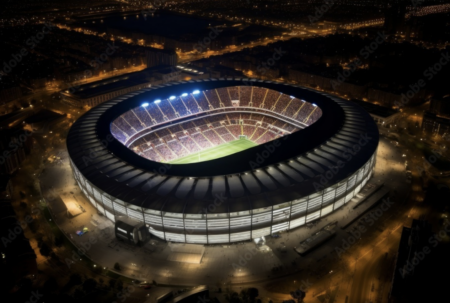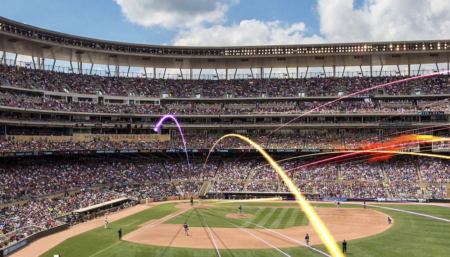Legendary stadium designer Dan Meis is unafraid to challenge convention. In the week that his iconic new Everton FC stadium hosted its first game, the man behind the Staples Center and scores of other legendary venues discusses his move into soccer, how the industry is evolving and how he feels about his ‘offspring’
***
Dan Meis is director of global sports design with AECOM. He is also, though he’s unlikely to admit it, a legend. Not many architects get featured in Time magazine’s “100 Innovators in the World of Sports”. Only one in fact – Dan Meis.
Not that one would know it. To speak with Meis is to be in the presence of great humility, a man humbled by his own achievements, albeit still determinedly doing things his way. His X (formerly Twitter) bio states that he is a “hater of rules”. Starting out over 30 years ago, Meis soon put this into practice.
“My very first opportunity to design an NFL Stadium was for the Cincinnati Bengals,” he says speaking from AECOM’s New York office – though he spends most of his time out in LA, Malibu to be precise.
ABOVE: to read the article in full visit the digital edition of Stadia Magazine from October 2024
“In one of my early meetings with team owner Mike Brown, he said, ‘it’s really hard for us to sell corner seats. Nobody wants to sit in the corner’. Because I hadn’t done the building type before, I said, ‘I don’t think it’s a law, why don’t we just take those seats away?’ It’s hardly rocket science, but it certainly broke the mold. We were the first NFL stadium that had open corners where you can see out of the stadium and people driving by the stadium can see in. It was the first time that an NFL stadium had kind of been broken apart, and it ended up influencing future stadia.”
Impressive back catalogue
Meis’s storied career began back in 1992 as lead designer on the Manchester Arena. Since then, numerous highpoints include the Staples Center arena in Los Angeles (now the Crypto.com arena), T-Mobile Park in Seattle, Paycor Stadium in Cincinnati, Lincoln Financial Field in Philadelphia and Saitama Super Arena in Saitama, Japan. More recently he has turned his attention to soccer, most notably AS Roma in Italy, and the new Everton FC stadium in Liverpool.
“I was very skeptical that I, an American, could be hired by a club like Everton, a traditional English football club with such a rich heritage,” he says. “I was skeptical to even meet with them originally, but I fell in love with the club and became so deeply involved with the fans. Everton really got into my blood.”
Representing the community
With his awareness of Everton as a ‘local’, historic club, Meis was keen to create something that fed into the community, rather than “dropping some sort of spaceship object into Liverpool”. But when he first drew on such ideas, the chairman hated it.
“He understood where I was coming from, but he didn’t want it to feel old-fashioned. He wanted ‘new’, but still to fit in.”
In the end much of the design was driven around the idea of feeling like the new stadium grew out of the docks, hence the brick piers, but juxtaposed with a more contemporary roof form.
“If you look at the bowl itself, it’s in keeping with the English tradition of four straight stands right on top of the pitch. It’s quite a no-nonsense building. When it opens next season, it will be interesting to see what people make of it. There might be fans who will think, ‘what’s the big deal? This isn’t as fancy as Tottenham!’ (see ‘Touchdown’, p14). It may not have all the bells and whistles, but it will feel like a proper football ground, and the fans will be right on top of the pitch. I think it’ll be very intimidating for the opposition.”
Having had his appetite whetted by his experience in the EPL, Meis would relish the chance to work with Manchester United on their own historic ground, Old Trafford, nicknamed The Theatre of Dreams.
“We actually did a pretty extensive piece of visioning work for Old Trafford, right before the pandemic. So I have spent a lot of time with them. And it’s an incredibly celebrated club. It’s always fascinating to me how the building was destroyed in World War Two, yet it’s still a viable football stadium. In America, unfortunately, we turn those buildings over in 20 years and you’ll see a club pick up and move if they don’t get a new building. I have a lot of respect for the sense of history that goes along with those historic English football grounds.”
Industry shifts
One of the challenges with an NFL stadium is that its basic use amounts to only 15-20 games a year. With so few dates it’s hard to rationalize the kind of investment regularly seen, hence one of the major shifts Meis has witnessed during his three decades
in the industry.
“The more you can make stadiums multi-purpose and connected to their environment, the better. That’s probably the biggest change we’ve seen, the way stadiums have become urban generators and urban connected buildings. But also technology; physical technology in the buildings, from the way you buy things and concessions and merchandise, to ticketing. Everything’s held in your hand now. How fans interact, both with the experience and with their phones. You’re watching the game, but you’re watching other games on your phone, or you’re taking a selfie at the event. It’s not only about being at the event, it’s being able to share on social media that you’re there. That’s certainly changed the experience. Then you have places like Intuit Dome that just opened, that’s a whole other level of arena experience.”
From sketch to reality
Meis has worked on many projects, each one incredibly complex, each employing thousands of people to complete them, often based on, “little napkin sketches where it started”. And yet, despite schedules and budgets and all the complexity, for Dan Meis at least, the finished product is pretty much the same one that first appeared in the sketches and the renderings.
“There are always aspects that you wish you could have done differently, but if you look at the original sketches and the original renderings, that is the building that ends up being built. It’s something I work very hard towards. It doesn’t always happen that way. Sometimes designers are very surprised that what they build is not what they thought they were going to build, but that hasn’t happened to me in my career. I would like to think it’s because I’m very passionate about the idea, and fight for things that I believe are important.”
With so many stadia to his name, Dan Meis has a lot of offspring out there, his own progeny, albeit forged in steel and concrete. Which means a lot of venues and grounds close to his heart.
“I was at Everton a few weeks ago and we walked around and the club recorded my reactions. It’s incredibly humbling, and it feels a little magical. To go from the original idea and the sketches to the end result, it’s hard to describe. And even though with Everton I literally got daily updates, from drone footage right through to to people driving by the building documenting the progression, somehow when you’re there, it’s something else. I can’t wait for that first day, when I see it full of fans, and that noise. Even though it’s been years, and hundreds of people, and millions of dollars or pounds, it’s hard to believe it has all come to pass, and it is extraordinarily moving.”






